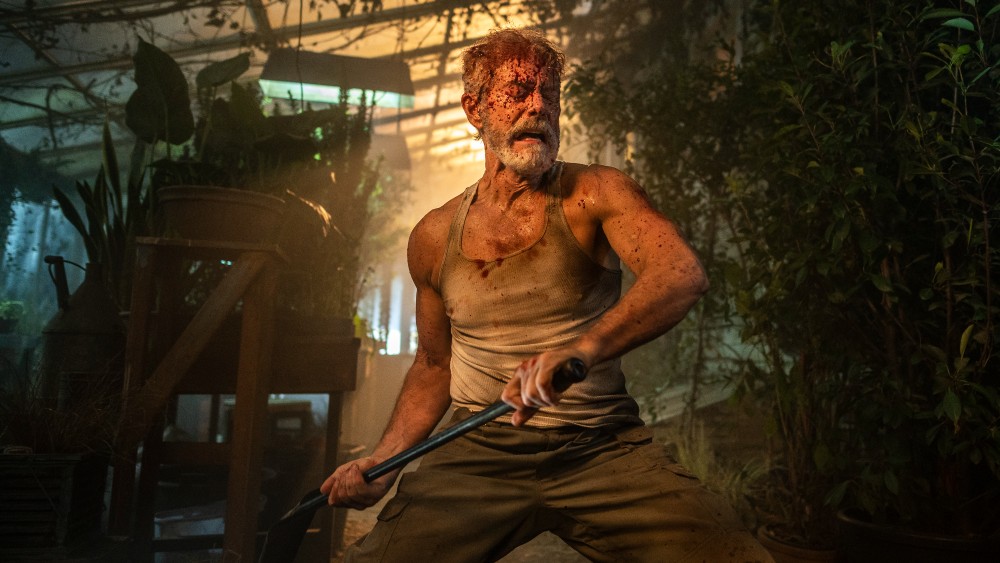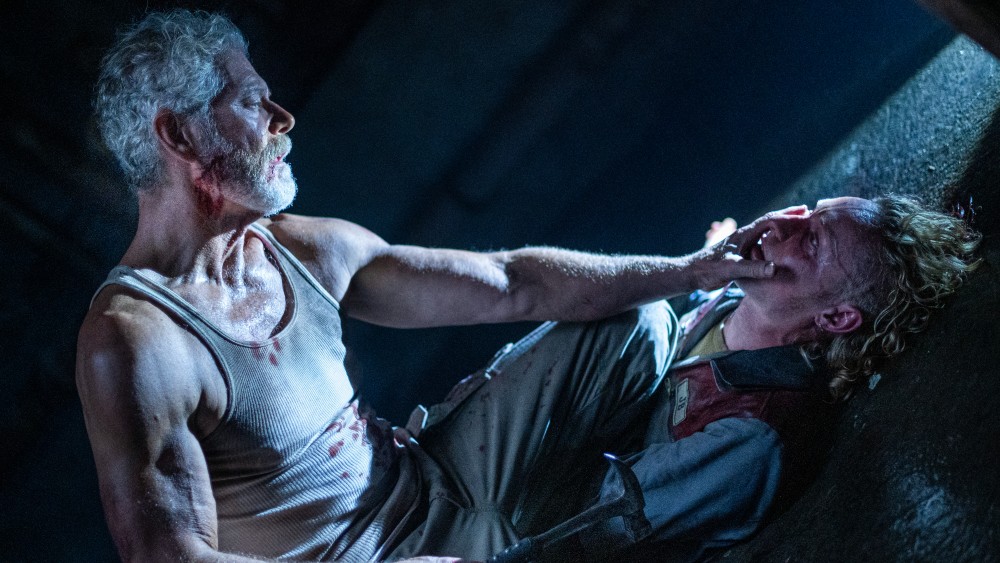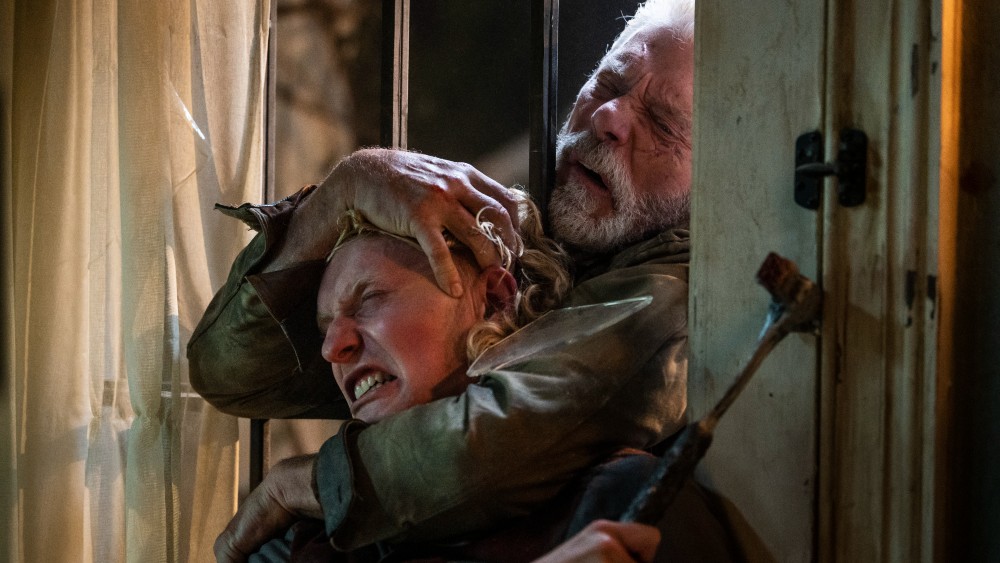
Something that connects many, if not all, of this summer’s horror-thrillers is the fact they all sound great, and the audio is just as crucial to the films’ effectiveness as the visuals. That’s especially true with Rodo Sayagues’ Don’t Breathe 2, a sequel to the 2016 thriller that was Sayagues’ directorial debut after co-writing both installments.
Don’t Breathe 2 isn’t your typical horror movie, though, as it’s a home invasion movie that’s more about creating the tone and supporting the violent fight sequences that usually involve Stephen Lang’s unnamed blind man.
That’s where the work of Supervising Sound Editor Mandell Winter and Sound Designer P.K. Hooker became so important, and the duo spoke with Below the Line recently to explain their separate duties, how they work together, as well as how each of their jobs is affected by how they collaborate with Composer Roque Baños.
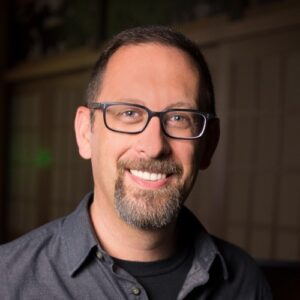
Below the Line: I thought the sound work on the sequel was just as good as that on the first movie. Before we begin, I’d love to know about your backgrounds and how you got into your respective fields of sound.
Mandell Winter: I got into sound kind of through the boutique studio route, and kind of worked my way up through there and eventually worked my way over to Sony, and started working with a bunch of other folks. So that’s kind of my route.
PK Hooker: I moved out here from Chicago in 2004, and just through blind luck hooked up with Skip Lievsay, and him and this other guy, Jerry, just sort of introduced me around and got me started, so just sort of organically fell into it.
BTL: Do you two often work together?
Hooker: This was our first time.
Winter: Yeah, it’s our first time working together.
Hooker: We’ve known each other for a while, and we’ve seen each other in the halls, and so this is our first time getting to collaborate.
BTL: I always wondered about when a sound team is put together where a lot of the same people are hired as a unit or not.
Hooker: I think a lot of times it goes down like that, but sometimes, the path to partnership is pretty circuitous. I think in this case, Mandell had done the last movie with Fede, and then Lionsgate and I have a really good relationship, so I think they were just like, well, this seems like a good way to just kind of pair up these two. So Mandell does all the talky bits, and then I do all the designey-soundy bits, and it worked out really well. You’re always a bit anxious around these kinds of things, because you never know what another person is going to bring and if they’re going to jive with you. It was pretty seamless, and the results I think are pretty good.
BTL: Oh, absolutely. I had a chance to watch it in a theater, and it sounded great. As I watched the movie, I actually tried to imagine what certain scenes might feel like without the sound effects as a bit of an experiment. I’m not sure how many people realize how little of what they’re hearing is actually captured on set.
Hooker: Mandell is the arbiter of all things captured on-set that go in the movie, so I think he can answer that.
Winter: We did use most of the production for the talky bits. We did strip it out. There’s this great one shot where we really let PK’s work shine, going through the house, and then we just sweetened here and there with a little ADR for some of the breathing and just keeping people present in the scene.
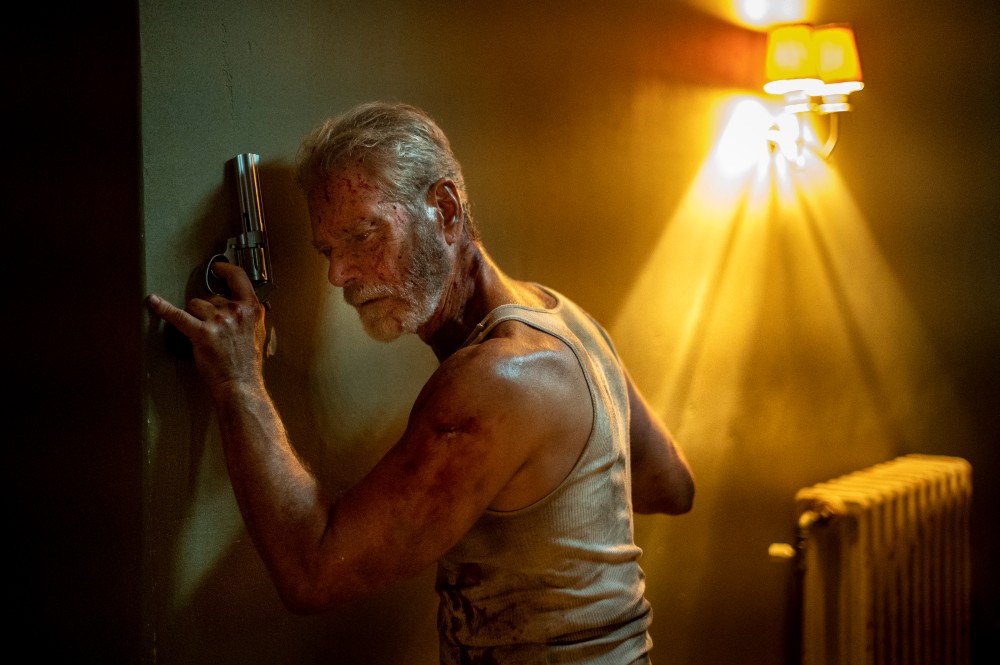
BTL: So Mandell, you’re on set while they’re shooting as well?
Winter: No, not at all. I take the recordings from set, and then we kind of sort through them, and then clean them up and make them work. And then, PK does all the design work and handles the effects side of everything.
Hooker: So a lot of it’s kind of like Mandell will clean up the dialogue and sort out what we call PFX, which is just the actual recordings from the day of things that happened, and then I will either replace them or enhance them. Because a lot of times, obviously, like when someone shoots a gun, or someone stabs someone or someone swings a punch, the sound from the actual event is usually pretty underwhelming. I think for a movie like this, also, the stance of Rodo and Fede in their presentation, and also I think in a more general sense of their directing acumen is sort of a gonzo approach. They want things to be bigger than life, so they want all the guns and everything to just be massive. And super as hard as we can push them, so the movie hits really hard. I think a lot of that was you just have to work stuff in, like punches and stuff, that are just crazy big.
BTL: Are either or both of you involved even before they start shooting? Or do you join after they’ve already filmed and recorded everything?
Winter: On this particular project, it was after they had shot. There are other projects where I’m involved very early, and this particular one, we came on towards the end.
Hooker: Same. I mean, oftentimes I’ll be brought in earlier. A lot of it has to do with budget, too. This is a lower-budget film, so I think they can’t really burn weeks of us hanging out, kicking about stuff. They need us to be putting sounds in a movie.
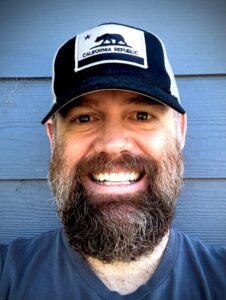
BTL: For you, PK, is it better to have a script and know what sort of work you’ll have to do in advance, or is it better that they have some sort of edit before you start?
Hooker: I always like [having] a script. Certainly, as a supervisor, I often am hired directly by the filmmaker, so I always want to read the script before I have that meeting with them. I think that a lot of the tone and ideas of things can come off the page. For this one, it certainly did, and the writing is really, really good. I think that because Rodo wrote it and directed it, he’s got a very clear vision about what he wanted to get. So, the script was really representative of what I eventually saw from the edit. At the end of the day, it’s always better to have the actual thing in your hand, so you can actually put the sounds to it. It’s a much more creative and interesting conversation creatively to have with the project is to just like actually have it and start putting sounds in and chucking it back to the director, so they can respond to you. And then, it feels like you’re really making a movie.
BTL: Mandell, you mentioned using sounds and dialogue from the set, so I assume the stuff recorded in the house on stages is pretty easy, but what about when they were shooting outside in Detroit? How usable is that dialogue?
Winter: Oh, it was very usable. Our production mixer did a really good job, and in fact, while we were mixing it, he would email us and ask, because he wants to grow, and so he was like, “What can I do better?” It was great to have that communication with him because I could give him real-time feedback. I’d be like, “This is working really great.” One of the hardest things in the track is really the subtlety of Norman’s performance. He has this very deep voice and very low-level efforts sometimes, and we’ve really had to kind of dig those out. But other than that, it was recorded fairly well, and it cleaned up.
BTL: What is your process when you have an edit? Do you start from the beginning and just go through it or do you focus on parts that might be more challenging?
Hooker: I think my approach has always been that there are some things that are kind of meat and potatoes. In a movie like this, the cars and stuff like that. The two editors, Jan [Kovac] and Yvonne [Valdez], did a great job adding sounds to the movie, so I think they filled a lot of the gaps in, so I would always try and do the more highly conceptual stuff that’s really hard to nail down and requires something more than than a functioning level of sound edit skills. Sometimes, that’s driven by the filmmaker. I would say in this particular instance, it was driven by the filmmaker in that Rodo, who wrote it, sent me specific scenes to do specific things before I even had a cut of the movie, so I just started in like little chunks. As they were getting through their assembly, early on with the picture edit, they would finish the scene that needed some design, and they would send it to me, and I would do a pass on that and send it back. In this case, the process was driven by them, because they had specific requests for some of the more sonic weird things in the moment, like when he follows the bell sound to the van. When he follows the bell sound to the van, that sort of ringing bell sound, and then again, later on when he’s fighting in the basement, and the water comes on, and he’s sort of discombobulated and can’t really get his bearings, because the sound is so overwhelming. It seems like those two scenes specifically were sent to me very early, because they didn’t know what they could do to sell it with the sound.
Winter: For me, I didn’t get involved during that early stuff. I mean, I participate in meetings, but I really didn’t dive in until we were working towards final, and then I just dove in and started cleaning up dialogue and figuring out what we needed to ADR. Since a lot of our actors were in London, it was super early mornings trying to figure out, “Okay, how do we make this work?” Because it would be their afternoon, and we just worked through it.
BTL: How big a team do you have and are they usually in-house studio people or are each of you putting together some sort of team either on the dialogue or sound effects side? And how big a team do you have?
Winter: On the dialogue side, there were two of us.
Hooker: Yeah, and on the effects side, it’s pretty scalable based on the project. I had, I think, two additional editors to myself, helping me out, throughout the process, not necessarily all at the same time. A lot of that’s based on schedule, and how much help we can pack into the project. But it’s all like people you know that you trust, people I’ve worked with before.
Winter: That’s an important part of it.
Hooker: Yeah, it really is.
BTL: Are you working together at any point or are you literally doing your own thing? Do you share files back and forth with each other? How much communication do you have with each other?
Winter: Oh, we talk fairly often. I mean, we check in with each other, and see how everything was moving forward, and just keep each other abreast of what was going on.
Hooker: Communication is pretty essential. I feel like, again, along the way, there are moments where the two worlds of dialogue and design kind of meet up. Those are like the moments where we really, really need to talk, but just from the leadership stance, we were always in communication about how to deal with scheduling, how to deal with when to bring people on and off the movie, based on what the temp mix and final mix schedule is going to be — it’s a lot of scheduling.
BTL: I know Rodo has the same composer who did the first movie, so I assume you, PK, are working with him more because the composer might do some musical sound effects type stuff like percussion. How do you guys integrate with that aspect of it?
Hooker: I always try and keep an open mind. I always see supervising and design as a sort of active service to the director, so I’m less interested in putting my sounds in the movie than I am putting the right sounds in the movie and the sounds the director wants to have in the movie. I always hope that any composer I collaborate with, is going to be open to that, because there’s a huge center to that Venn diagram between music and design, and a lot of times you butt heads, inadvertently, not in an aggressive way, but you sort of end up trying to occupy the same space. I think that Roque [Baños] was very collaborative, because there was a fair amount of that where he had done a lot of work, and I Had done a lot of work in the same sort of vein, and we had to choose between one or the other to try and make them work together. There’s a lot of opportunities for him to step back, so I could step in, and vice versa, for him to step in and I could step back, and we went through it very smoothly — he was really open to it. There’s some scenes, like the house hunt, where there was a bunch of music that we just didn’t play, so that sound could just have its moment. And then there were other moments where there was a lot of music, and the design was just kind of like, “Well, the music’s doing a great job, so let’s just let it.” This was a really successful and satisfying collaboration with Roque, that was my impression of it.
BTL: Mandell, do you have to worry about where music is going to be and make sure it’s not stepping on the dialogue.
Winter: Oh, I have to worry about where the music and effects are going to be, because we’re trying to dig out that performance and make sure we can hear it. Sometimes, like in this particular movie, there’s a lot of very subtle performances and the nuance, and it can be tricky how to get that to cut through when there’s huge action moments happening. And you’re like, “How am I going to get this to cut through?” So, you clean it up the best you can, and we had great mixers that were able to dip the effects or the music just a little bit, so you can get just enough of the performance through, and vice versa, and let the let it soar when we don’t need to have the performance really cut through.
Hooker: I would say again, the mixers, like Mandell was saying, are such a huge part of a successful collaboration. A lot of it is just finding a place in the soundtrack for everything that’s happening. Someone’s chasing somebody, they shoot him with the gun, the guy screams. I mean, there’s a big moment that just involves everything — there’s huge driving music, there’s a big gunshot, there’s a big scream. How do you make it all work? And you kind of need it all to be there, and so, Mixers Brandon Proctor and Nick Offord did a great job really sort of clearing out the space we needed to get these big set pieces, which were pretty complex, to all work together.
BTL: I assume you both have done a couple projects in the last year, so what have you done during the pandemic to do your jobs? Have you been working a lot from home? How has it affected your work and have you been doing anything that you think you might just keep doing even after the pandemic is over?
Hooker: I can say that I’ve pretty much been exclusively working from home since the pandemic, and honestly, even before that. I had built a home studio, and I’ve been working from home pretty much throughout, except for mixes, which we go to mixing stages for, so that’s like the only time I ever sort of work out of my house. I’ve been fortunate in that, because the pandemic, as far as my personal work and experience, hasn’t changed a lot. Mixes are a little weird. I mean, Rodo was in Uruguay for the whole thing.
Winter: For me, I moved home. I guess it was a year ago, March. I had an office over at Sony that I used to go to every day, and I think I’m gonna keep it hybrid for now, and maybe do a few days a week down there eventually. I’m able to do Source Connect from home. if my actors are remote, I’m bouncing from ADR stage to ADR stage, and then to the mix stage. It changed a little bit, but not that much. I’m still able to communicate with everyone, and do what I need to do.
BTL: Do you have to send mics and preamps to the actors so they could set them up to do ADR from home?
Winter: Not on this particular project. On this one, we were able to get everyone into the ADR stage. On other projects, I did have to do that, but not on this particular one.
BTL: Are either of you working on anything now, we’ll be seeing or I guess I should say “hearing” soon?
Winter: Nothing I can say anything about right now, but yeah, I’m working on several things.
Hooker: Kind of the same answer. I’m working on a couple of things that I don’t know exactly when they’re going to come out, because the pandemic has deeply affected everything that happens after we finish. So it’s like we’re in this new world of like, “Is it theatrical? What does that even mean anymore?” There’s hopefulness, and everything going around, but yeah, I’m working on a couple things that hopefully will be in the theaters. But, you know, we’ll see what happens.
BTL: Have either of you had a chance to sit in a theatre with a good speaker system and watch a movie other than when you’re mixing things?
Hooker: We had the luxury, because of how prepared everybody in picture edit and the directors were to finish their movie, we had the luxury of watching Don’t Breathe again, a couple of times, all the way through during the dub. I feel like the last time we played it through it was a pretty good experience of that film. I feel like my answer is yes, but I haven’t seen it since the mix.
Winter: Neither have I. That was the last time I saw it was on the playbacks.
Hooker: The only time I’ve been to a movie theater, since this pandemic, was recently for a recruited screening on a project I’m working on. That’s the only time I’ve been to a movie theater in almost two years now.
Don’t Breathe 2 is still playing in theaters nationwide. You can also read our interviews with filmmakers Rodo Sayagues and Fede Alvarez and Cinematographer Pedro Luque, and read our review.
All photos courtesy Sony Pictures, except where noted.

